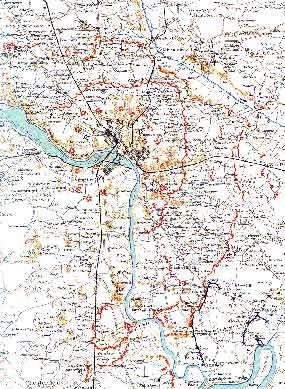
NPS In the spring of 1862 General George B. McClellan’s army of more than 100,000 Union soldiers landed at Fort Monroe and fought its way up the peninsula. By mid-May the Army of the Potomac lay on the outskirts of Richmond. McClellan planned to capture the capital of the Confederacy and perhaps end the war. If his strategy succeeded the nation might be reunited, but without the abolition of slavery. In June the city’s defenders, members of the Army of Northern Virginia, had a new leader. Confederate General Joseph E. Johnston had conducted the campaign through May, but he fell wounded at the Battle of Seven Pines just east of the city on May 31. His successor, General Robert E. Lee, inherited a gloomy set of circumstances. His 65,000 man army would fight with its back to Richmond. Several variables affected the events in June. Sickness ravaged both armies, particularly McClellan’s. The volatile weather, with extensive rain, greatly injured the Union army’s complicated supply system. Being far from home, that army relied on shipping, wagon trains, and the Richmond & York River Railroad to keep itself fed and clothed. McClellan required an estimated 700 tons of supplies every day merely to stay in the field. The rain produced unbelievably muddy roads, forcing the railroad to assume an even greater portion of the transportation burden. The Chickahominy River, swampy even in the best of times, raged across a wide valley northeast of Richmond. That river divided the Army of the Potomac. 
General Lee reorganized his army and through the first three weeks of June emphasized the construction of earthen fortifications nearly encircling the city. That unpopular directive earned Lee the derisive nickname “King of Spades.” But Lee had a plan for the salvation of Richmond, and those fortifications were a key ingredient. By erecting powerful defenses, he intended to leave a relatively small portion of his army to guard the direct line to Richmond while he took the balance and attacked McClellan. Confederate general Thomas J. “Stonewall” Jackson and his army were important components in Lee’s strategy. On June 8-9, Jackson completed the defeat of three Union armies in the Shenandoah Valley. With the Valley temporarily secure, Jackson could reinforce the imperiled capital. His 20,000 men would bring Lee closer to numerical parity with McClellan. Their arrival, under Lee’s plan, would trigger the offensive. Jackson’s men moved by railroad and by foot. When they approached Richmond from the northwest on June 26, Lee struck. With Stonewall Jackson advancing along the northern side of the Chickahominy, Lee began moving much of Richmond’s defense force toward Jackson. Together, Lee hoped, they could threaten McClellan’s supply railroad and trigger a decisive battle for the fate of Richmond. The ensuing week of operations produced five major battles and several smaller ones and resulted in the Union army retreating to the banks of the James River. With Richmond secure, Lee’s army moved north, defeated Union forces at Cedar Mountain and Second Manassas (Bull Run), and then marched toward Maryland and the first invasion of the North. |
Last updated: February 1, 2018
